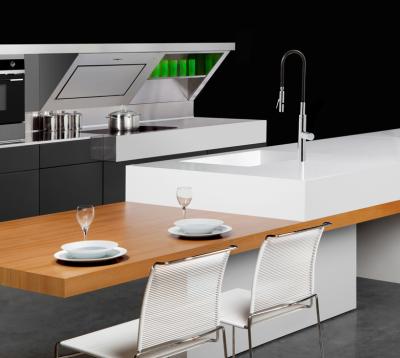
Larger and heavier benchtops will require support which is designed to take the weight. Image by Caesarstone.
Bench height
Height requirements for kitchen benches may vary, but the height is typically measured as the distance between the floor surface and the bench surface. The evenness of the floor also needs to be taken into account; however most kitchen benches should be between 850mm to 1050mm, with the most common height being 900mm (which is a good fit for most under-bench appliances).
Taller or shorter families are likely to benefit from having a raised or lowered benchtop.
Bench depth
The nominal depth of most benches is 600mm, however design, materials, supporting cabinetry and wall variations may require that a different depth is used.
Bench overhang
The recommended overhang from the edge of the bench to the front face of the floor cabinet is 20mm. For aesthetic reasons, this should be consistent throughout the kitchen. There are safety aspects to this sort of consistency too - it'll ensure that you know how much overhang there is throughout the kitchen, which will help prevent you from accidentally banging your wrists, hips or other parts of your body on a bench you expect to be shorter. The maximum variation here should only be about +/- 2mm.
Bench thickness
Different bench materials come in different standard thicknesses, although it's up to you (or your kitchen designer) to decide how thick you'd like your benches to be. Throughout the kitchen, there should only be +/- 3mm variation in thickness between all of your bench surfaces, unless you're using natural products which involve some natural variation. In that case, a variation of 5mm is acceptable. As for the surface level, acceptable variations are normally 3mm over a distance of 2 metres.





